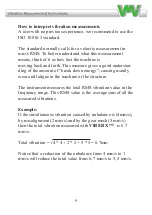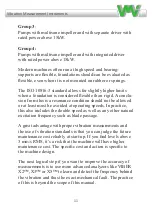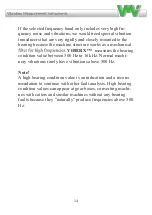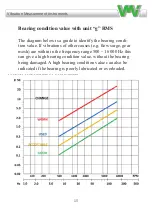
15
Vibration Measurement Instruments
the machine structure works as a mechanical fi lter for high
frequencies.
VIBER X1™ is measuring the bearing condition value between
500 Hz to 20 kHz. Within this frequency range a common
experience exist in the evaluation of the bearing condition level.
Normal machinery vibrations rarely have vibrations above 500 Hz.
Note!
A high bearing condition value is an indication and a
recommendation to continue with other fault analysis.
High bearing condition values can appear at gear boxes,
converting machines with cutters and similar machines without
any bearing faults because they “naturally” produce frequencies
above 500 Hz.
Manual Viber X1_121002.indd 15
10/3/12 9:26 AM
Bearing condition value with unit “g” RMS
The diagram below is a guide to identify the bearing condi-
tion value. If vibrations of other causes (e.g. flow surge, gear
mesh) are within in the frequency range 500 – 16 000 Hz this
can give a high bearing condition value, without the bearing
being damaged. A high bearing condition value can also be
indicated if the bearing is poorly lubricated or overloaded.
Vibration Measurement Instruments
Bearing condition value with unit “g” RMS
The diagram above is a guide to identify the bearing condition
value. If vibrations of other causes (e.g. fl ow surge, gear mesh) are
within in the frequency range 500 – 6400 Hz this can give a high
bearing condition value, without the bearing being damaged.
A high bearing condition value can also be indicated if the bearing
is poorly lubricated or overloaded.
Manual Viber X1_121002.indd 16
10/3/12 9:26 AM
Bearing condition value with unit “g” RMS
The diagram above is a guide to identify the bearing condition
value. If vibrations of other causes (e.g. flow surge, gear mesh) are
within in the frequency range 500 – 16 000 Hz this can give a high
bearing condition value, without the bearing being damaged.
A high bearing condition value can also be indicated if the bearing
is poorly lubricated or overloaded.






































